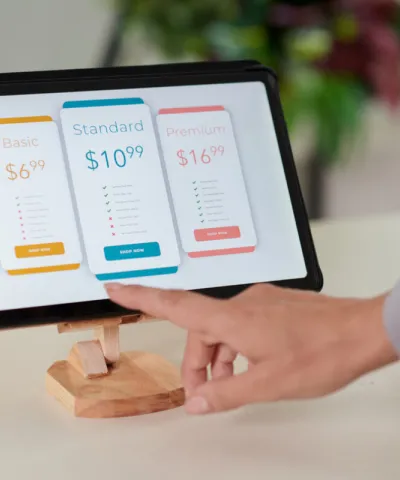How do you make sure you give the right prices to all the right people? It’s a difficult question to answer, but the best strategy is price segmentation. Let’s dive into how price segmentation unlocks greater profit potential.
Prices are rarely static, even when a product or service doesn’t change. Many variables can lead a price to change. Also, different people are willing to pay different prices.
To account for variation between customer groups, price segmentation helps you maximize profits while meeting customer needs.
What is price segmentation?
Price segmentation (price differentiation) means offering different groups of customers different prices. Different groups of customers (segments) pay a different price based on any mix of a wide range of factors.
Simply put, price segmentation means applying different prices based on customers' willingness to pay. It is based on the understanding that price sensitivity varies greatly between customers.
Common examples of price segmentation include:
- Age. A movie theater charges different rates for children, adults, and seniors. Prices are set according to the perceived price sensitivity of each group. Children’s tickets are half cost or less to attract families. Seniors pay less to account for a (normally) fixed income.
- Purchase volume. Most wholesalers and distributors offer a progressively lower price per unit based on volume. However, many retailers do the same.
- Bundling. Instead of paying for one product or service, companies offer a bundle of products and/or services. The total cost is significantly less than the price of each individual products and services put together.
In addition to these, a more complete list of factors would include:
- Age
- Time
- Location
- Bundling (upsells)
- Demographics
- Product form
- Usage rights
- Purchase volume
- Point of purchase
- Conditions of product/service
Price segmentation strategies account for the specific factors that affect customer’s price sensitivities. Those factors vary by business.
Price segmentation examples
Airlines are more likely to use conditional price segmentation. For example, they may charge a higher fare for cancelable/flexible bookings. They also normally segment by time of purchase, offering different prices depending on the time of day or even day of the year. Lastly and most noticeably, they offer different seating arrangements at vastly different prices.
So, airlines segment prices based on:
- Time of purchase
- Conditions of service
- Size and location of seating
Restaurants, bars, coffee shops, and fashion businesses are also likely to segment prices by the time of purchase. Happy hour deals and a “meal of the day” are common examples. This helps them get customers in the door during normally slow business hours.
What are the benefits of price segmentation?
We often recommend price segmentation to our clients for its versatility. Many businesses have room for improved profitability. A price segmentation strategy means finding that room.
Increased profit
Companies segment their prices to ultimately increase their profits. They do so by meeting the needs of their most significant customer segments.
First, they identify and then target segments willing to pay higher prices. These segments may pay more for:
- Premium service
- Add-ons
- More
Second, some customer segments with higher price sensitivity can simultaneously be accommodated.
In the end price segmentation maximizes profits by capturing the widest possible customer base. You avoid loss by not pricing products too high or too low. The full value of your offerings can be appreciated by different customer segments.
Higher customer LTV
Price segmentation enables you to gain a higher customer lifetime value from certain customers. At the same time, it accounts for the needs of potential customers with much higher price sensitivities.
The point is that regardless of what customers need, price segmentation strategy lets you adjust your pricing methods to meet their needs. You provide more value to every customer and build stronger relationships with those willing to spend more.
Market penetration
Your customer base is likely not as large as it could be without price segmentation.
Price segmentation strategy has you reach out to a larger share of your market. By charging different prices based on relevant factors, you can capture more of your market and gain an edge.
When to use price segmentation?
Price segmentation is a sensible strategy to implement in many cases. However, it is more important to consider a price segmentation strategy under certain circumstances.
Check out our recent work with an international imaging company.
Diverse customer base
The most important sign that price segmentation is important is a very diverse customer base. When customers have widely varying preferences, it almost necessitates price segmentation.
We recommend a thoughtful approach to price segmentation when your customers:
- Have widely varying purchase behaviors
- Demonstrate different purchase preferences
- Demonstrate widely different price sensitivities
- Live in a wide range of locations
Product differentiation
If you offer similar products with a wide range of functionality and other differences, consider price segmentation.
This is another reason why many companies lean heavily into this strategy. If you offer different sets of features to different market segments, you need to segment your prices. Aim to align each price with the perceived value for each product, service, or bundle.
Market expansion
If you want to appeal to new market segments, you need to segment your prices.
Price segmentation is necessary when you are expanding under certain conditions. Different locations and their different average incomes, among other factors, may necessitate price segmentation.
Seasonal variation
Most apparel retailers use seasonal price segmentation. This aspect of the strategy helps you maintain profitability on out-of-season items.
You can demand a higher price for apparel that is currently or soon to be in season. You can also get a baseline profit from out of season apparel at the same time. By doing this you are appealing to customers with different spending habits and budgets.
Similar logic applies in other businesses as well.
Gaining a competitive edge
In highly competitive markets, it’s crucial to differentiate your offer. Price segmentation is used in such situations as an additional tool for differentiation.
To this end, you can use unique pricing options, value-added services, and customized bundling. These methods and similar ones are tailored to specific customer segments.
What are the different criteria for price segmentation?
Price segmentation can be beneficial but can have drawbacks. It’s an approach to pricing that deserves close research and attention.
Here is a basic rundown of how price segmentation is implemented.
Understand Your Customer Base
Thorough market research of your customer base and its segments is the first order of business. Begin the process with a fresh understanding of your broad customer base. Start with research on:
- Customer demographics
- Purchase behavior
- Your market as a whole
If you don’t have it already, gather this key data through surveys and past purchase history.
After that, identify the most significant customer segments. The segments that will be useful to you are clusters of customers that share key characteristics. The most important are behaviors such as purchase behavior and other signs of loyalty to your brand.
These new segments will be the foundation for your new price segmentation strategy.
Determine customer price sensitivity
Price sensitivity or willingness to pay is based on many factors. Customer segments will be willing to pay different prices based on value drivers:
- Quality
- Extra features
- Convenience
- Brand reputation
- Personalization
- Social status
- Safety
- Ethical considerations
- Non-price financial benefits
Find the value drivers through market research, past behavior, and surveys. Use this data to set separate prices that would appeal to each segment.
Set your prices
Set different prices for each customer segment. This step may involve serious pricing changes, discounts, and the application of other pricing strategies.
Monitor the results & adjust as necessary
Once your new pricing strategy is implemented, pay close attention to the results. You may notice changes in behavior and changes in segments’ value drivers.
When you notice negative changes, adjust your pricing as necessary. High price elasticity may present new challenges. It is normal to take a few steps back and readjust based on unforeseen changes.
Is price segmentation a sound strategy?
We normally advise price segmentation with customer centricity and a larger strategy in mind. Price segmentation should not be avoided when business circumstances call for it. The price segmentation examples we’ve covered are just some of the occasions to focus on the strategy.
Price segmentation offers your business a great way to maximize profits with a diverse customer base. It’s a flexible strategy that requires work but helps you capture a larger market share. The catch is that you must be careful to avoid misunderstandings during the process. Clear communication internally and with your customers helps avoid confusion.
How Simon-Kucher can help
Simon-Kucher offers invaluable expertise in assisting companies with implementing effective price segmentation strategies. By identifying and analyzing distinct customer segments based on factors such as price sensitivity, brand image, and target markets, we help businesses tailor their pricing structures to maximize profitability.
Through meticulous segmentation, companies can better understand the varying needs and preferences of their customers, allowing them to offer differentiated pricing strategies that resonate with each segment. Whether it's implementing value-based pricing for premium segments or offering discounts for price-sensitive customers, we ensure that companies can optimize their pricing strategies to capture the maximum value from each customer segment.
With a deep understanding of different types of price segmentation techniques, we empower companies to achieve their revenue and profitability goals while maintaining a competitive edge in the market.
Learn more about price segmentation and how to implement a price segmentation strategy. Contact us today!




